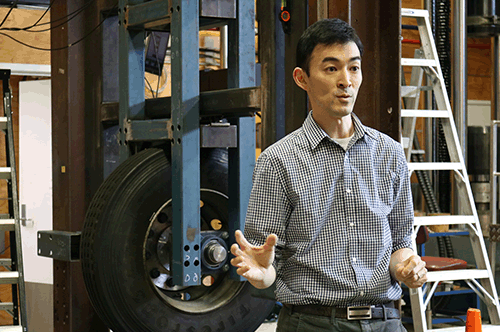WSP Opus – paving the way for better roads
Dr Jeremy Wu gave IRANZ members and the Prime Minister's Chief Science Advisor, Prof Juliet Gerrard, a run-down on the research being conducted at the WSP Opus Research facility in Petone. Photo Louise Thomas.
WSP Opus have several exciting projects on the go, everything from developing roading materials using waste streams such as tyre rubber and plastics with bitumen, modifying chip seals and other road surfaces with non-bituminous materials that are less prone to water damage, to creating roads that will last for 40 years before needing replacing.
National Manager WSP Opus Research, Wendy Turvey, and materials scientist Dr Jeremy Wu gave IRANZ members and the Prime Minister's Chief Science Advisor, Prof Juliet Gerrard, a tour of the WSP Opus Research facility in Petone on 13 September. This is where the R&D happens for our nation's roadways.
Dr Wu outlined several of their current projects, “We have been working with waste tyre-derived crumb rubber modification into bitumen binders in collaboration with Fulton Hogan and the material has been trialled successfully on a one-kilometre section of cycleway in Upper Hutt. The feedback from a wide spectrum of users gathered by our behavioural researchers has been overwhelmingly positive.” The project has been co-funded by the Ministry for the Environment and the NZ Transport Agency in an effort to investigate one of the solutions to ‘end-of-life’ tyres.
The research team is also behind a four-year MBIE-funded research programme called “Waterproof Roads”. Dr Wu says almost 90% of the New Zealand road network is highly susceptible to water damage. New Zealand roads are typically made of a compacted aggregate basecourse layer over which multiple chip seal layers are constructed. “WSP Opus has been working on non-bituminous membrane materials and other technologies, so this new generation of ‘chip seals’ is less prone to water damages. This will extend the life of roads and reduce annual maintenance and construction costs for what is considered as one of the country’s biggest assets.”
An example of bringing research to life is the story behind epoxy-modified open graded porous asphalt (EMOGPA). Surfacing of Wellington’s new Smart Motorway was recently completed using a novel long-life asphalt developed at WSP Opus Research in partnership with the roading industry for the New Zealand Transport Agency. This is the first time EMOGPA has been used in Wellington and provides a more durable, quieter ride into and out of the city.
The development of the epoxy modified asphalt was driven by the user benefits it provides for the public and the cost savings resulting from the very long life expected. As well as being a low-noise asphalt, this type of surface allows free drainage of rainwater which will improve traffic safety through enhanced skid resistance and provide better visibility from reduced tyre spray. Conventional OGPA suffers from a shorter useful life. For road users, the long life expected from epoxy OGPA also means reduced delays, lower costs and fewer road works. EMOGPA is now used in a number of major projects in Auckland, Christchurch, and Wellington.
For more about WSP Opus Research please see: https://www.wsp-opus.co.nz/services/research/
Date posted: 13 August 2018

